Constructed from scratch 30 years ago, Slavutych was intended to be a "paradise" after the infamous nuclear disaster — but it hasn't exactly worked out as planned.

Getty ImagesFacade of an unfinished church in Slavutych, Ukraine.
Chernobyl: the very name conjures up the images of never-ending fires, radiation poisoning, brutal deaths, and a population forced to carry on with DNA mutated by the nuclear fallout.
All of this is true, and the disaster has captured the world’s imagination, not the least of which has crested in HBO’s hit series with the same name.
But for all the intensely negative consequences, there was a phoenix that rose from the ashes. Namely: Slavutych, a bustling Ukrainian town and Soviet-style oasis, built to house the survivors of the blast.
The Chernobyl Disaster
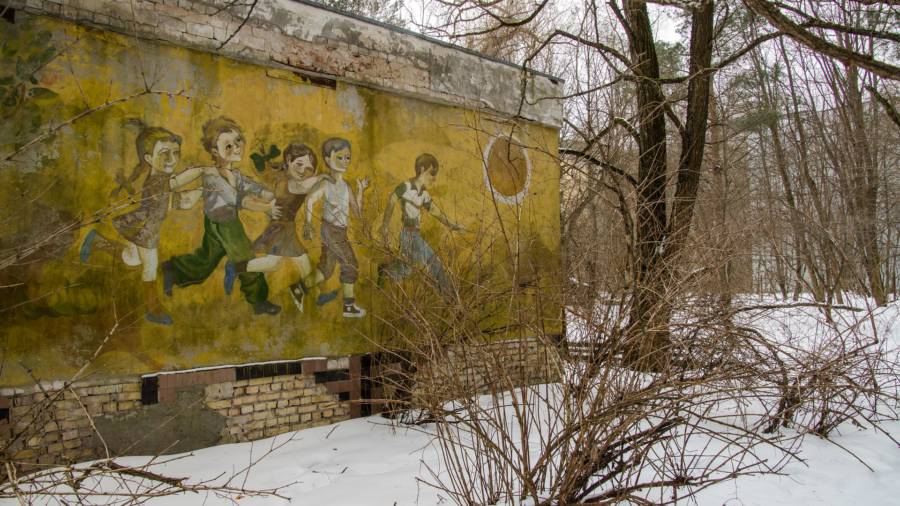
PixabayA mural in Pripyat depicting children before the meltdown. 2018.
On April 25 and 26, 1986, Ukraine (and the rest of the world) experienced one of the worst disasters in human history, rendering part of the country uninhabitable for an estimated 20,000 years.
The world became familiar with the name of the nuclear plant in the form of explosions, perpetual fires, and a sick populace.
It all started after a test was administered to a nuclear reactor on the site to see if it would remain stable at low power.
The test rendered the reactor unstable, so the workers removed around 200 control rods. But when the rods were inserted again — all at the same moment — the graphite tips of the rods caused a chemical reaction.
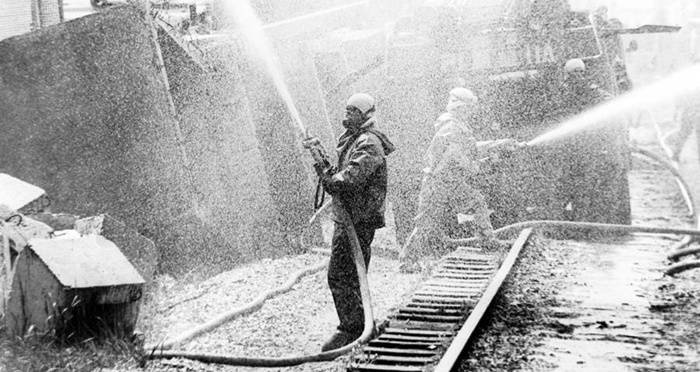
Vitaliy Ankov/RIA NovostiWorkers hosing the plant down with a decontaminant. 1986.
Steam and gas coupled with the massive chemical reaction set off an explosion that rocked the world. At least 28 people reportedly died in the initial blast. More than 100 were injured.
The disaster, however, was just beginning.
The Fallout After Chernobyl
Due to miscommunications, it took nearly 36 hours for evacuation of the surrounding area, including the nearby town of Pripyat, to take place.
Built in 1970 to house workers of the plant, Pripyat soon became part of the nearly 350,000 people evacuated by the Soviet Union. Meanwhile, a 19-mile exclusion zone was built around the doomed reactor.
Some brave workers stayed behind to fight the blaze, now known as the “Suicide Squad.” From above, helicopters dumped tons of sand on the fire. But it still burned for two weeks.
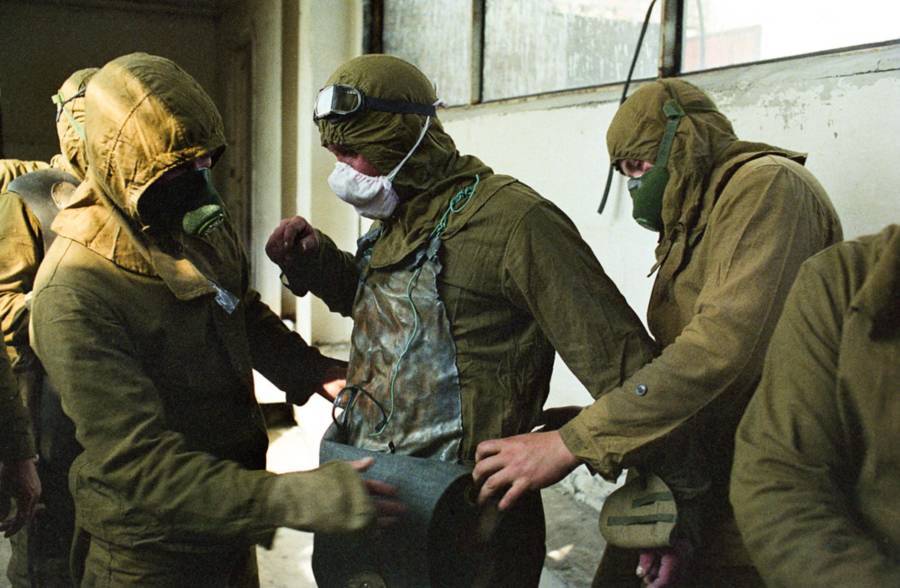
Igor Kostin/Sygma/CorbisSpecial clean-up workers known as “liquidators” suit up.
Despite the danger, workers braved the region to assist in clean-up. “They had workers going in there every day without respirators, and the lighting was almost non-existent,” said Laurin Dodd, a U.S. citizen working to support the new “sarcophagus” structure over the the reactor’s remains.
A 2006 study by a group of UN agencies decried the “imperfections” of the poorly-sealed previous model, built quickly to cover the remaining waste.
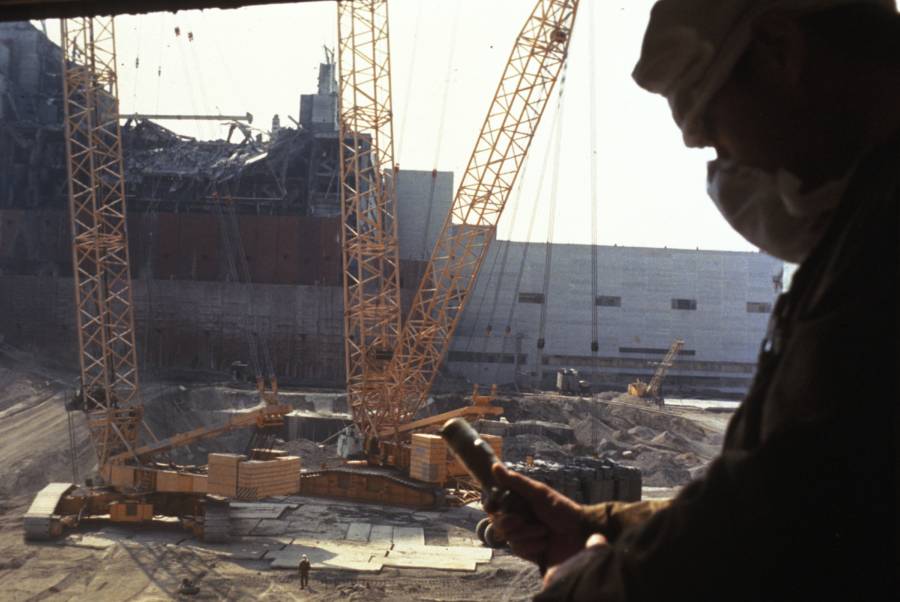
Sovfoto/UIG via Getty ImagesA worker recording radiation levels during construction of a new sarcophagus. 1986.
The decades-long coverage of the cancers, radiation poisoning, and other health issues caused by the nuclear exposure is well-documented. A 2005 U.N. report contends that the greatest challenge of Chernobyl has been the effect that the disaster has had on the 600,000 people in the area.
Building Slavutych

A woman walks past an administrative building in Slavutych, Ukraine. 2016.
Despite the horror of Chernobyl and the immediate aftermath, what came from the ash was a remarkable place carved from virgin forest.
Slavutych was designed as the ideal Soviet town, mostly taking inspiration from other cities and countries. For instance, there’s a Tbilisky quarter that boasts traditional Georgian crosses on balconies. There’s also a Yerevansky quarter with architecture inspired by Armenia’s pink houses.
Meanwhile, other districts have a minimalist design with wooden cabins.
The area’s terrain was originally so radioactive that the city’s builders had to bring in enough safe soil to pile it six feet high atop the contaminated ground below.
But almost like magic, the new city was announced just six months after the disaster. It was constructed from scratch in just two years — and with it came an idyllic oasis out of the radioactive ash of Chernobyl.
“In a land filled with charmless settlements,” said American writer Matthew Brzezinski, “Slavutych could almost have passed for the West.”
Slavutych took pride not only in its Soviet-style glory, but also its Western-style amenities: kids played on real playgrounds and went to excellent schools. The houses even had front lawns.
The town was attractive for young adults as well. The average age of the citizens was 30, and the town was considered the richest in Ukraine during the 1990s.
Slavutych Today

Getty ImagesA man buys cigarettes before taking the train in Slavutych, Ukraine.
Currently, the town is suffering something of a slump. The final retiring of Chernobyl in 2000 caused many people to lose their jobs.
Abuse of drugs and alcohol is widespread. Paramilitary troops often practice in the surrounding forests. And many residents are just plain bored.
However, the Chernobyl site remains an ideal launchpad to study atomic radiation and its effects. It’s just a 45-minute train ride away from Slavutych.
The local politicians have high hopes. Mayor Yuri Fomichev has said: “We will be the city of energy. Not just nuclear energy.”
Changes Since Chernobyl
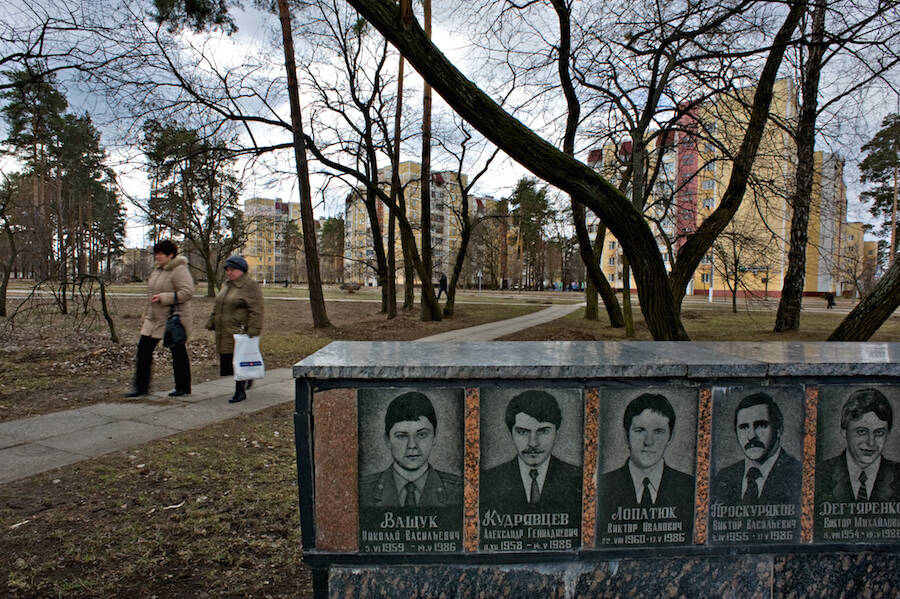
Getty ImagesA memorial in Slavutych to those killed in Chernobyl.
Believe it or not, some 1,200 residents of the exclusion zone refused to relocate to Slavutych, choosing to live in a region of radioactive soil. According to CNN, many of the surviving residents are older women, who have lived through years of political unrest, genocide, and famine.
After everything they’ve been through, they don’t want to bother fleeing an enemy that’s invisible to them — especially if it means relocating to an urban environment where they might struggle.
As one self-settler named Hanna Zavorotnya put it: “Radiation doesn’t scare me. Starvation does.”
Indeed, as photography expert Esther Ruelfs commented on recent pictures of the region: “We look onto a tranquil, peaceful world, a positively paradise-like, apparently pre-industrial idyll. Humans live in close symbiosis with animals, slaughtering takes place at home, apples ripen on the windowsill.”

Getty ImagesMonument in Slavutych in memory of the liquidators who died while cleaning up after the Chernobyl disaster.
Like everywhere else, northern Ukraine is full of more living things than just people. Mostly untouched by humans, flora and fauna are flourishing in Chernobyl’s infamous Red Forest.
Organisms like elk and lynxes are rebounding, and in 2015 it was estimated that seven times more wolves lived within the exclusion zone than in nearby comparable reserves.
Slavutych, as well as the entire region of the Chernobyl site, are testimonials to the rebound of life in a seemingly hopeless situation.
After this look at Slavutych, the city built to house Chernobyl survivors, take a look at these eerie photos inside Chernobyl’s exclusion zone. Then, learn how the Chernobyl disaster site has become a hotbed for sexy selfies.





